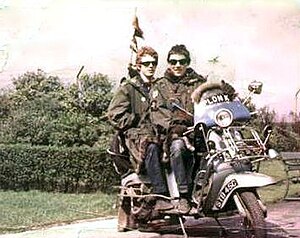
Back حداثي (ثقافة فرعية) Arabic Movimientu mod AST Mod Catalan Mod (subkultura) Czech Mod (subkultur) Danish Mod (Subkultur) German Mod-movado Esperanto Movimiento mod Spanish Mod Basque Mod (nuorisokulttuuri) Finnish

Mod, from the word modernist, is a subculture that began in late 1950s London and spread throughout Great Britain, eventually influencing fashions and trends in other countries.[1] It continues today on a smaller scale. Focused on music and fashion, the subculture has its roots in a small group of stylish London-based young men and women in the late 1950s who were termed modernists because they listened to modern jazz.[2] Elements of the mod subculture include fashion (often tailor-made suits); music (including soul, rhythm and blues, ska and mainly jazz) and motor scooters (usually Lambretta or Vespa). In the mid-1960s when they started to fade out, the subculture listened to rock groups with R&B influences such as the Who and Small Faces. The original mod scene was associated with amphetamine-fuelled all-night jazz dancing at clubs.[3]
During the early to mid-1960s, as mod grew and spread throughout Britain, certain elements of the mod scene became engaged in well-publicised clashes with members of a rival subculture: rockers.[4] The mods and rockers conflict led sociologist Stanley Cohen to use the term "moral panic" in his study about the two youth subcultures,[5] in which he examined media coverage of the mod and rocker riots in the 1960s.[6]
By 1965, conflicts between mods and rockers began to subside and mods increasingly gravitated towards pop art and psychedelia. London became synonymous with fashion, music, and pop culture in these years, a period often referred to as "Swinging London". During this time, mod fashions spread to other countries; mod was then viewed less as an isolated subculture, but as emblematic of the larger youth culture of the era.
As mod became more cosmopolitan during the "Swinging London" period, some working class "street mods" splintered off, forming other groups such as the skinheads. In the late 1970s, there was a mod revival in Britain which attempted to replicate the "scooter" period look and styles of the early to mid-1960s. It was followed by a similar mod revival in North America in the early 1980s, particularly in southern California.[7][8]
- ^ Cite error: The named reference
lifewas invoked but never defined (see the help page). - ^ Jaquest, Oonagh (May 2003). "Jeff Noon on The Modernists". BBC. Archived from the original on 11 January 2009. Retrieved 11 October 2008.
- ^ Wilson, Dr. Andrew (2008). "Mixing the Medicine: The Unintended Consequence of Amphetamine Control on the Northern Soul Scene" (PDF). Internet Journal of Criminology. ISSN 2045-6743. Archived from the original (PDF) on 13 July 2011. Retrieved 11 October 2008.
- ^ Cite error: The named reference
Brawlwas invoked but never defined (see the help page). - ^ "Folk Devils and Moral Panics". Routledge. Retrieved 18 June 2023.
It was Stanley Cohen's classic account, first published in the early 1970s and regularly revised, that brought the term 'moral panic' into widespread discussion.
- ^ British Film Commission (BFC) (PDF), Film Education, archived from the original (PDF) on 4 July 2008
- ^ Page, Michael (2006). "A rather disjointed narrative of the California mod scene(s) 1980–1983". california-mod-scene.com. Archived from the original on 20 June 2009. Retrieved 11 October 2008.
- ^ Artavia, Mario (2006). "SoCal Mods". South Bay Scooter Club. Archived from the original on 9 December 2008. Retrieved 11 October 2008.